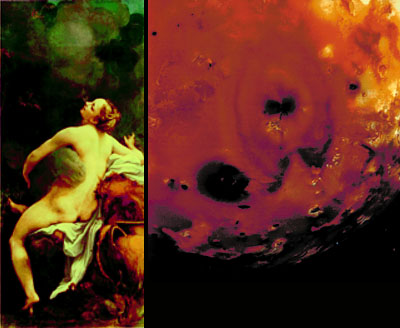The following discussion provides only two simple illustrations of the many different value-added development to images that can be created by our team.
To get to this point an end-user has clicked on the Earth system in the entry page, and subsequently clicked on the image of the moon to get a closer look at the body. Figure 1 appears, with an associated informational window describing the image, how it was obtained, and what it means. In this case, the color scheme is explained and related to lunar geology. The user might then access an explanation of our understanding of volcanism on the moon as it is related in this image via a hpertext reference: "lunar volcanic lava flows" as shown in the sample below.
Figure 1 - The Earth's Moon - As viewed from the Galileo spacecraft on December 7, 1992.
This false color image of the moon is made of a series of 53 images taken by the galileo space probe. The northern polar regions of the moon are shown. The colors show the different kinds of rocks that make up this region of the Moon. Bright pink areas are lunar highlands. Blues and oranges show lunar volcanic lava flows.
Our hypothetical user wants to learn about Jupiter, and has clicked on the image of the Jupiter system in the initial display. A zoom-in image of that system then appears, including the best actual images available at that time of Jupiter and it's attendant moons. The associated informational window would include a brief description of the Jupiter system and its unique features. Subsequent clicks on the planet and her moons would allow the user to investigate Jupiter and the moons in turn and to delve further into higher resolution images of the planet or the moon of interest, where available. In this example, our user wants to learn about Jupiter's moon Io, and is particularly interested in the volcano Loki and it's mythological connection (Figure 3).

Figure 3 - An example of an image that a user might encounter while learning about the Jovian moon Io. The painting is an art historical artifact associated with the volcano Loki.